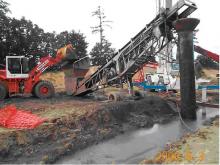Data provider
Budapest University of Technology and Economics, Department of Applied Biotechnology and Food Science, Environmental Microbiology and Biotechnology Group
Contact details
Compulsory sheet of the technology
Financing of the project
Application sphere
- Halogenated aliphatic organic compounds
- trichloroethylene
Description of environmental risk
Information on the technology
In the construction of a 7.6 m long, 0.8 m wide and 10.4 m deep experimental permeable reactive barrier (PRB), 90/10% iron/sand mixture was placed into the trench using a tremie pipe (Sivavec et al., 2002). Sand and granular iron (Conelly-GPM, -8+50 mesh) were mixed at the site using concrete-mixing trucks. The reactive material was placed in the trench using tremie pipes. Care was taken to minimize segregation and contact between the iron/sand mixture and the biopolymer. Following placement high pH enzyme breaker (Rantec LEB-H, 3.81) was added to the fluid to break the remaining biopolymer in the trench and clay was placed on the barrier to prevent contact with air.
Biopolymers were first used as additives to stabilise trench walls during excavation. Through the advancements achieved by their use, the additive application has been developed into a new technology. The procedure exhibits similar features to traditional slurry trenching, the main difference being that biopolymer (e. g. guar gum) is added to the stabilising suspension and enzyme breaker used to break the remaining biopolymer.
Technology classification
- subsurface permeable reactive soil zone
- subsurface Permeable Reactive Barrier (PRB) (simple)
Technology-monitoring
Costs of the technology
SWOT (evalaution based on scores)
SWOT (evaluation in words)
Improved slurry trenching technology for PRB which uses biopolymer to enhance trench stabilisation during excavation and enzyme breaker following placement of the reactive material.
Potential segregation of sand and iron during placement.
Technology enhancement for PRB construction.
None.
Completed applications
Publications, references
Sivavec, T., Krug, T, Berry-Spark, K. and Focht, R. (2002) Performance monitoring of a permeable reactive barrier at the Somerworth Sanitary Landfill Superfund Site. In: Simon, F.G., Meggyes, T., McDonald, C. (eds) Advanced groundwater remediation. Thomas Telford Publishing. London. 87 - 100.
Sivavec, T.M. (2001) Long-Term Performance Monitoring of Permeable Reactive Barriers, Prepr. Paper ACS Natl. Meeting, Am. Chem. Soc., Div. Environ. Chem. 41(1), 1181-1184.
